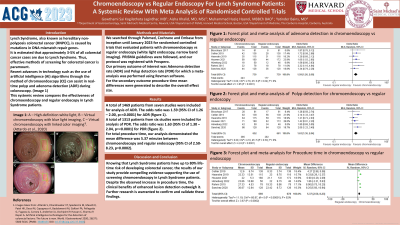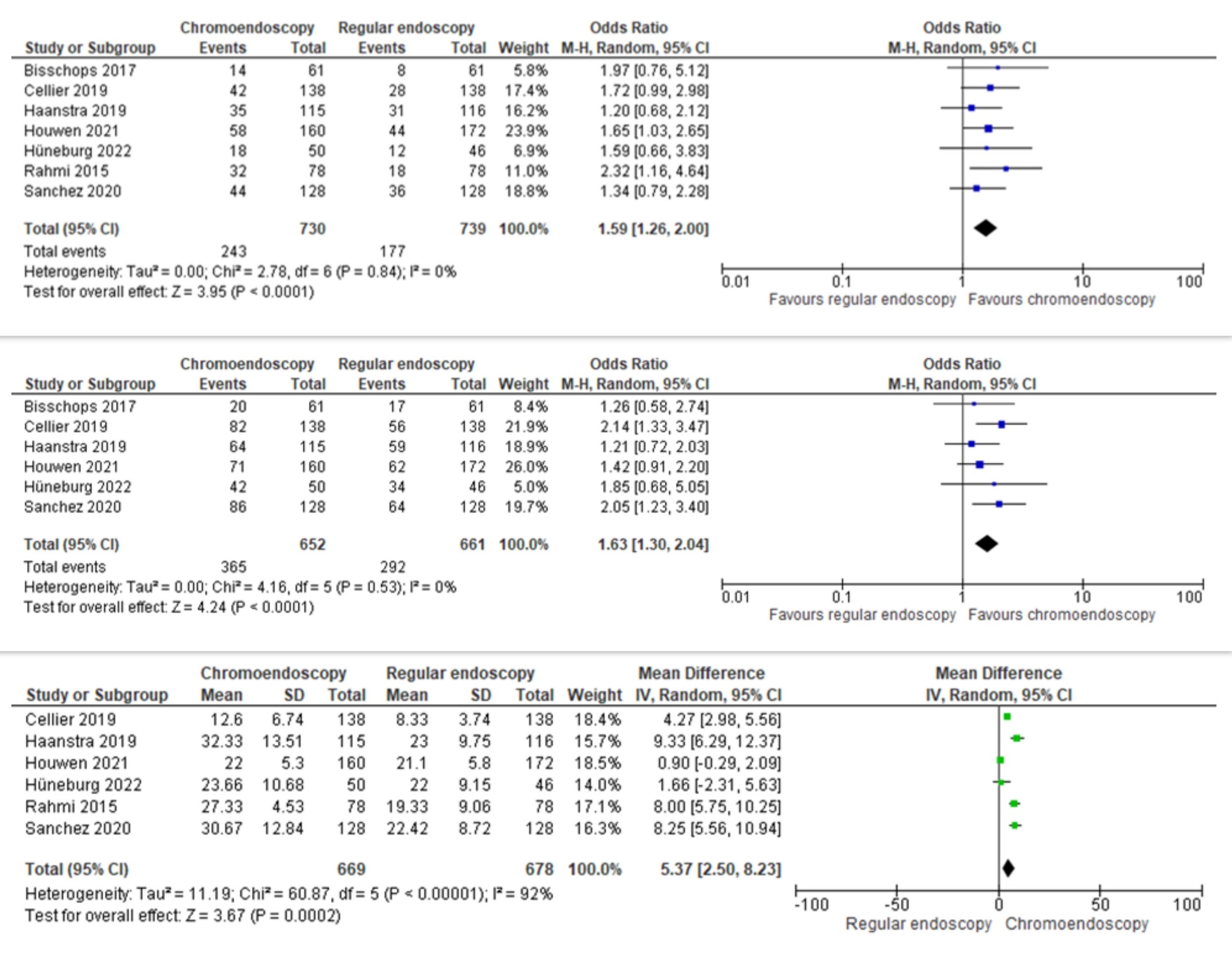Tuesday Poster Session
Category: Colon
P3039 - Chromoendoscopy vs Regular Endoscopy for Lynch Syndrome Patients: Systematic Review With Meta-Analysis of Randomized Controlled Trials
Tuesday, October 24, 2023
10:30 AM - 4:00 PM PT
Location: Exhibit Hall

Has Audio

Gowthami Sai Kogilathota Jagirdhar, MD
Saint Michael's Medical Center
Newark, NJ
Presenting Author(s)
Gowthami Sai Kogilathota Jagirdhar, MD1, Aisha Khalid, MD2, Haziq Hasnol, MD2, Yatinder Bains, MD1
1Saint Michael's Medical Center, Newark, NJ; 2Harvard Medical School, Boston, MA
Introduction: Lynch syndrome, also known as hereditary non-polyposis colorectal cancer (HNPCC), is caused by mutations in DNA mismatch repair genes, primarily MLH1, MSH2, MSH6, and PMS2. It is estimated that approximately 3-5% of all colorectal cancer cases are due to Lynch syndrome.
Recent advances in technology such as the use of artificial intelligence (AI) algorithms through the method of chromoendoscopy (CE) can assist in real-time polyp and adenoma detection(ADR) during colonoscopy. This systematic review compares the effectiveness of chromoendoscopy and regular endoscopy in Lynch syndrome patients.
Methods: We searched through Pubmed, Cochrane, and Embase from inception till Jan 2023 for randomized controlled trials that evaluated patients with Chromoendoscopy Vs Regular endoscopy (white light endoscopy, narrow band imaging). PRISMA guidelines were followed and our protocol was registered with Prospero. Our primary outcome of interest was the Adenoma detection rate (ADR) and Polyp detection rate (PDR) for which a meta-analysis was performed using RevMan software. Random effect models were used and the Mantel-Haenszel odds ratio was generated to describe the overall effect size. For the secondary outcome procedure time mean differences were generated to describe the overall effect size using random effect models.
Results: A total of 1469 patients from seven studies were included in the qualitative analysis for ADR. The odds ratio was 1.59 for rate detection with a 95% confidence interval(95% CI) of 1.26-2.00, I2 =0%, and p=< 0.0001. (Figure 1) A total of 1313 patients from six studies were included in the qualitative analysis for PDR. The odds ratio was 1.63 for rate detection with a 95% confidence interval(95% CI) of 1.30-2.04, I2 =0%, and p=< 0.0001. (Figure 1) For total procedure time, the qualitative synthesis showed that the mean difference was 5.37 minutes between the Chromoendoscopy and Regular endoscopy groups and a 95% CI of 2.50-8.23, I2 = 92%, and p= 0.0002. (Figure 1)
Discussion: The results of this study provide compelling evidence supporting the use of screening chromoendoscopy in Lynch syndrome patients. Despite the observed increase in procedure time, the clinical benefits of enhanced lesion detection outweigh this slight drawback. Further research is warranted to confirm and validate these findings.

Disclosures:
Gowthami Sai Kogilathota Jagirdhar, MD1, Aisha Khalid, MD2, Haziq Hasnol, MD2, Yatinder Bains, MD1. P3039 - Chromoendoscopy vs Regular Endoscopy for Lynch Syndrome Patients: Systematic Review With Meta-Analysis of Randomized Controlled Trials, ACG 2023 Annual Scientific Meeting Abstracts. Vancouver, BC, Canada: American College of Gastroenterology.
1Saint Michael's Medical Center, Newark, NJ; 2Harvard Medical School, Boston, MA
Introduction: Lynch syndrome, also known as hereditary non-polyposis colorectal cancer (HNPCC), is caused by mutations in DNA mismatch repair genes, primarily MLH1, MSH2, MSH6, and PMS2. It is estimated that approximately 3-5% of all colorectal cancer cases are due to Lynch syndrome.
Recent advances in technology such as the use of artificial intelligence (AI) algorithms through the method of chromoendoscopy (CE) can assist in real-time polyp and adenoma detection(ADR) during colonoscopy. This systematic review compares the effectiveness of chromoendoscopy and regular endoscopy in Lynch syndrome patients.
Methods: We searched through Pubmed, Cochrane, and Embase from inception till Jan 2023 for randomized controlled trials that evaluated patients with Chromoendoscopy Vs Regular endoscopy (white light endoscopy, narrow band imaging). PRISMA guidelines were followed and our protocol was registered with Prospero. Our primary outcome of interest was the Adenoma detection rate (ADR) and Polyp detection rate (PDR) for which a meta-analysis was performed using RevMan software. Random effect models were used and the Mantel-Haenszel odds ratio was generated to describe the overall effect size. For the secondary outcome procedure time mean differences were generated to describe the overall effect size using random effect models.
Results: A total of 1469 patients from seven studies were included in the qualitative analysis for ADR. The odds ratio was 1.59 for rate detection with a 95% confidence interval(95% CI) of 1.26-2.00, I2 =0%, and p=< 0.0001. (Figure 1) A total of 1313 patients from six studies were included in the qualitative analysis for PDR. The odds ratio was 1.63 for rate detection with a 95% confidence interval(95% CI) of 1.30-2.04, I2 =0%, and p=< 0.0001. (Figure 1) For total procedure time, the qualitative synthesis showed that the mean difference was 5.37 minutes between the Chromoendoscopy and Regular endoscopy groups and a 95% CI of 2.50-8.23, I2 = 92%, and p= 0.0002. (Figure 1)
Discussion: The results of this study provide compelling evidence supporting the use of screening chromoendoscopy in Lynch syndrome patients. Despite the observed increase in procedure time, the clinical benefits of enhanced lesion detection outweigh this slight drawback. Further research is warranted to confirm and validate these findings.

Figure: Figure 1: Forest plot and meta-analysis of Adenoma detection, Polyp detection, and Procedure time in chromoendoscopy vs regular endoscopy
Disclosures:
Gowthami Sai Kogilathota Jagirdhar indicated no relevant financial relationships.
Aisha Khalid indicated no relevant financial relationships.
Haziq Hasnol indicated no relevant financial relationships.
Yatinder Bains indicated no relevant financial relationships.
Gowthami Sai Kogilathota Jagirdhar, MD1, Aisha Khalid, MD2, Haziq Hasnol, MD2, Yatinder Bains, MD1. P3039 - Chromoendoscopy vs Regular Endoscopy for Lynch Syndrome Patients: Systematic Review With Meta-Analysis of Randomized Controlled Trials, ACG 2023 Annual Scientific Meeting Abstracts. Vancouver, BC, Canada: American College of Gastroenterology.
